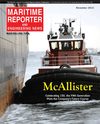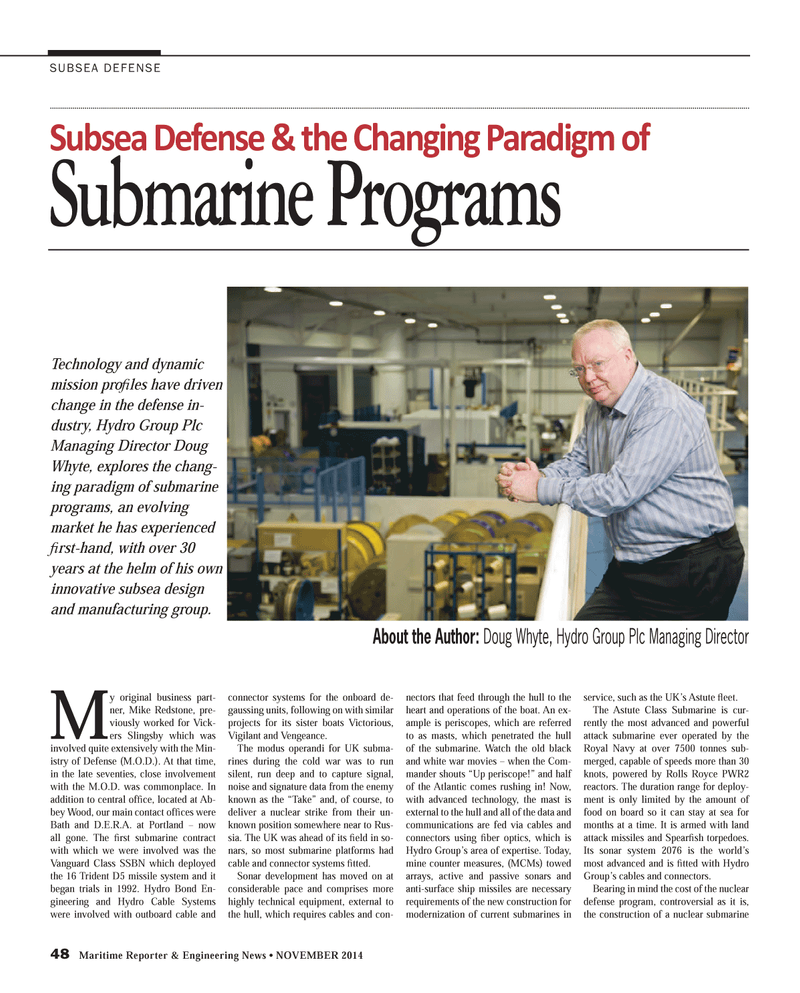
Page 48: of Maritime Reporter Magazine (November 2014)
Workboat Edition
Read this page in Pdf, Flash or Html5 edition of November 2014 Maritime Reporter Magazine
48 Maritime Reporter & Engineering News • NOVEMBER 2014
SUBSEA DEFENSE
M y original business part- ner, Mike Redstone, pre- viously worked for Vick- ers Slingsby which was involved quite extensively with the Min- istry of Defense (M.O.D.). At that time, in the late seventies, close involvement with the M.O.D. was commonplace. In addition to central of? ce, located at Ab- bey Wood, our main contact of? ces were
Bath and D.E.R.A. at Portland – now all gone. The ? rst submarine contract with which we were involved was the
Vanguard Class SSBN which deployed the 16 Trident D5 missile system and it began trials in 1992. Hydro Bond En- gineering and Hydro Cable Systems were involved with outboard cable and connector systems for the onboard de- gaussing units, following on with similar projects for its sister boats Victorious,
Vigilant and Vengeance.
The modus operandi for UK subma- rines during the cold war was to run silent, run deep and to capture signal, noise and signature data from the enemy known as the “Take” and, of course, to deliver a nuclear strike from their un- known position somewhere near to Rus- sia. The UK was ahead of its ? eld in so- nars, so most submarine platforms had cable and connector systems ? tted.
Sonar development has moved on at considerable pace and comprises more highly technical equipment, external to the hull, which requires cables and con- nectors that feed through the hull to the heart and operations of the boat. An ex- ample is periscopes, which are referred to as masts, which penetrated the hull of the submarine. Watch the old black and white war movies – when the Com- mander shouts “Up periscope!” and half of the Atlantic comes rushing in! Now, with advanced technology, the mast is external to the hull and all of the data and communications are fed via cables and connectors using ? ber optics, which is
Hydro Group’s area of expertise. Today, mine counter measures, (MCMs) towed arrays, active and passive sonars and anti-surface ship missiles are necessary requirements of the new construction for modernization of current submarines in service, such as the UK’s Astute ? eet.
The Astute Class Submarine is cur- rently the most advanced and powerful attack submarine ever operated by the
Royal Navy at over 7500 tonnes sub- merged, capable of speeds more than 30 knots, powered by Rolls Royce PWR2 reactors. The duration range for deploy- ment is only limited by the amount of food on board so it can stay at sea for months at a time. It is armed with land attack missiles and Spear? sh torpedoes.
Its sonar system 2076 is the world’s most advanced and is ? tted with Hydro
Group’s cables and connectors.
Bearing in mind the cost of the nuclear defense program, controversial as it is, the construction of a nuclear submarine
Subsea Defense & the Changing Paradigm of
About the Author: Doug Whyte, Hydro Group Plc Managing Director
Technology and dynamic mission pro? les have driven change in the defense in- dustry, Hydro Group Plc
Managing Director Doug
Whyte, explores the chang- ing paradigm of submarine programs, an evolving market he has experienced ? rst-hand, with over 30 years at the helm of his own innovative subsea design and manufacturing group.
Submarine Programs
MR #11 (42-49).indd 48 10/28/2014 10:41:03 AM

 47
47

 49
49
